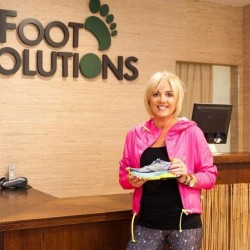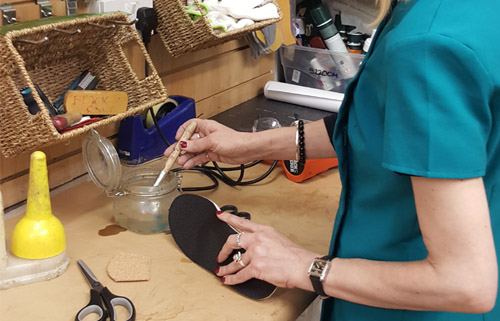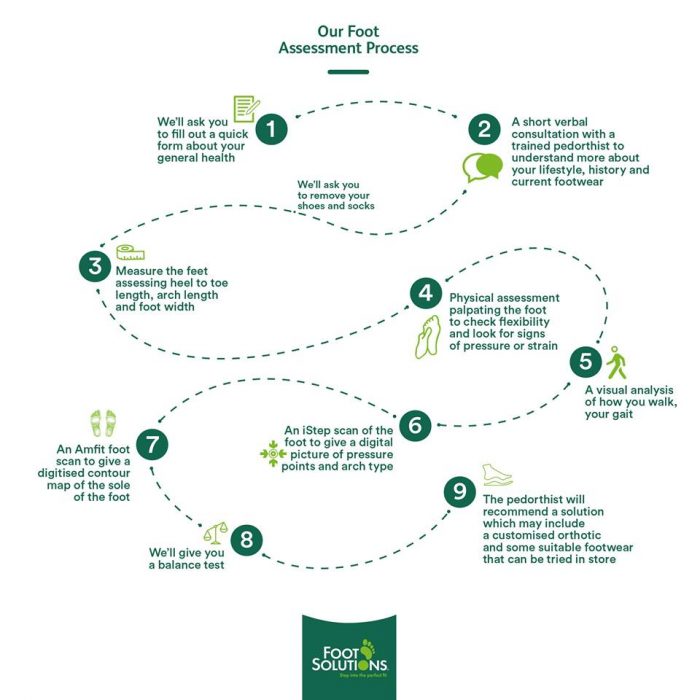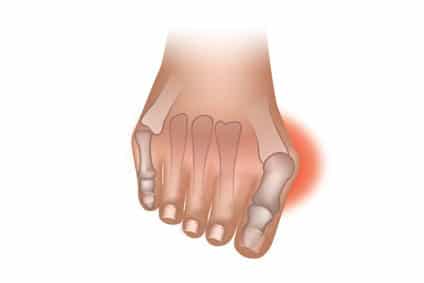Did you know that as we age, we lose weight from the fat pads on the under-sides of our feet? Weight loss in this area affects the cushioning around the balls and heels of the feet, and this creates greater pressure that can lead to calluses and corns.
If you are experiencing pain in your feet, it is a good idea to get this checked out as soon as possible. A visit to us at Foot Solutions can help to identify the cause of the pain you are feeling and find a solution that allows you to get back on your feet and enjoy a full and active life.
How Our Feet Work
Each foot is made up of 26 bones and more than a hundred tendons, ligaments and muscles that make up 33 joints. The feet carry a great burden of weight as they support our bodies all day long, and this puts them under great pressure. Foot pain and pain in the lower legs can be debilitating, but can often be resolved with a combination of great footwear, comfort socks and custom arch supports that help to provide the cushioning and shock absorption that your feet need.
The fat pad in the heel of the foot is located under the heel bone, and it is de-signed to function as a shock absorber within the foot. This pad is made up of fibrous tissue, and when it wears thin, there may be pain where the heel bone comes into contact with the skin. When the fat pad wears down, this is known as fat pad atrophy, and a custom orthotic or arch support can be a good option to give additional cushioning and support the more delicate areas that are no longer fully protected.
Fat Pad Atrophy and Foot Pain
One of the reasons that fat pad atrophy is such bad news for feet is that it is often connected with other conditions that cause foot pain. Many people are diagnosed with plantar fasciitis or heel spurs when their fat pads thin, but wearing a custom orthotic to replace the fat pad can solve the problem and relieve the pain at this stage. Untreated foot conditions can lead to further complications, however, so it is vital to get any pain checked out as soon as possible.
Why Do We Have Fat Pads in the Feet?
It is important to understand how the fat pads protect our feet in order to appreciate their important role.
The fat pads in the feet work together to absorb shock and cushion the feet as the full weight of the body is transferred through them. There is a fat pad beneath the heel and a group of five metatarsal fat pads beneath the heads of the toe bones, and these combine to protect the bones and the soft tissues of the feet when we move.
The plantar fat pad, which is located in the ball of the foot, beneath the heads of the toe bones, serves to cushion the pressure that the weight of the body puts on the ball of the foot as we walk and stand. When this pad wears out and thins, it is common to feel pain in the ball of the foot when standing and walking, and this may even affect the way we walk. When the soft tissues bear the brunt of our movement, rather than this being absorbed by the fat pads, this causes irritation, which can lead to inflammation and pain. It is common for calluses to form in this area, and knowing how to protect against this can help to reduce the risk of this painful condition.
What Causes Fat Pad Atrophy?
As our fat pads are so important to our continuing good health as we age, it may seem strange that they begin to wear out as we get older. It is important to consider the effects of our lifestyles on our feet, since we often give them a rough ride, and to think about how we can protect them against unnecessary damage.
Fat pad atrophy is caused by:
- Ageing. The fatty tissue in the fat pads of the feet and in the rest of the body is known as adipose tissue, and this naturally reduces as we grow old-er.
- Genetics. There is some variance in the speed and rate at which the fat pads wear out, and this is thought to be due to genetic inheritance.
- Rheumatoid arthritis. Those who have rheumatoid arthritis often develop contractions in the toe bones which can cause the fat pads on the balls of the feet to be displaced.
- Poor footwear or injury. Wearing the wrong shoes for your feet can cause similar effects to a serious injury to the foot, crushing the toes together and damaging or displacing the fat pads beneath them. This is especially common when high heeled shoes are worn frequently, and also when wearing shoes that have very thin soles.
- Diabetes. Diabetes can cause many problems for the feet, making it much more likely that damage and ulcers will occur. This often causes the fat pads to thin more quickly, and people with diabetes should be made aware of this risk.
- Treatment for Morton’s neuroma. Patient’s with severe pain due to Morton’s neuroma may opt for surgery to remove the nerve in the affected ar-ea, or try steroid injections. Both of these procedures have been known to damage the plantar fat pad.
- Surgery. Multiple surgeries in this area can damage and weaken the fat pads in the feet, or cause them to shift.
How to Treat Fat Pad Atrophy
 If the fat pads of the feet are damaged, you may notice localised pain, especially when walking barefoot, and the formation of calluses and ulcers. A visit to Foot Solutions can help you to work out the best way to address this problem with your feet, and you may find that our recommendations can help you to move around without pain once more. We use a ten point assessment to find out as much as possible about your feet and your lifestyle so that we can make suggestions that work, and our scans and tests give us a very effective picture of the best options for you.
If the fat pads of the feet are damaged, you may notice localised pain, especially when walking barefoot, and the formation of calluses and ulcers. A visit to Foot Solutions can help you to work out the best way to address this problem with your feet, and you may find that our recommendations can help you to move around without pain once more. We use a ten point assessment to find out as much as possible about your feet and your lifestyle so that we can make suggestions that work, and our scans and tests give us a very effective picture of the best options for you.
The following treatment measures can very effectively relieve the pain of fat pad atrophy and enable you to move comfortably:
1. Find good shoes. Shoes that are suited to your feet will fit you well, feel comfortable and suit your gait. You will feel the difference immediately when you wear shoes that cushion and support your feet properly.
2. Avoid excess pressure on the feet. The feet are used to bearing your weight, but it is important to avoid putting them under greater pressure than necessary by maintaining a healthy weight, avoiding high heeled shoes, avoiding bare-foot walking and avoiding exercises such as squatting that put pressure on the ball of the foot.
3.  Use custom orthotics. Custom-made orthotic devices that are designed to fit your feet are an excellent way to cushion the affected area and spread the force of the weight across the whole of your foot. Talk to us about custom orthotics and we will demonstrate the way in which these can cushion the most vulnerable bones and tissues of the feet and protect against pain and further damage.
Use custom orthotics. Custom-made orthotic devices that are designed to fit your feet are an excellent way to cushion the affected area and spread the force of the weight across the whole of your foot. Talk to us about custom orthotics and we will demonstrate the way in which these can cushion the most vulnerable bones and tissues of the feet and protect against pain and further damage.
Custom Orthotics for Comfortable Feet
A custom orthotic is a simple device that can make a world of difference to the way your feet feel. Your orthotic will be designed to fit your foot exactly, and if the intention is to replace the natural cushioning of the fat pad, the shape will be crafted to provide metatarsal support and a cupped heel. The material with which your orthotic will be made depends upon the aim of the orthotic and the end result you are hoping for, and this will usually be a mate-rial that offers great support and cushioning.
Find Comfortable Shoes at Foot Solutions
Here at Foot Solutions, our experienced pedorthists are on hand to help you to find the best options for your feet. We will take the time to carry out a nine point assessment of your feet and your lifestyle, and then make recommendations that will usually involve comfortable, well-fitted shoes, with comfort socks and/or custom arch supports.

Whether you are experiencing foot pain or want to get yourself in great shape for a new exercise regime or challenge, we can help. We see clients with all manner of foot problems, from plantar fasciitis to Athlete’s Foot, and our aim is to empower our customers to enjoy their active lives and get back to feeling great. Visit us at Foot Solutions for a professional fitting, or book an appointment online now and find the very best solution for your feet.

































